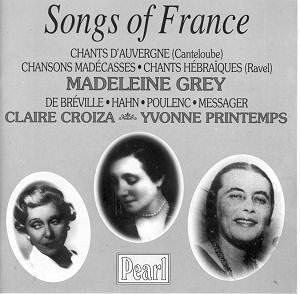More than half of this disc is accounted for by the
Ravel and Canteloube of Madeleine Grey. Grey was born Madeleine
Nathalie Grumberg on 11 June 1897 at Vilaines-la-Juhel in Mayenne. She
died in Paris on 13 March 1979.
Grey's vintage versions of the Canteloube songs
were my introduction to them. A handful were included by some adventurous
and well-informed producer in one of BBC Radio 3's morning programmes
back in 1971. Grey sounds more mature than my now favourite version
(Netania Davrath on Vanguard - presumably temporarily unavailable given
the demise of the Omega Group). She delivers the unruly kick of a lickerish
pony in L'Aio de rotso and does so with seamless breath control.
The orchestral sound has considerable heft, surprising given that it
is seventy years old. Woodwind are dominant in the sound-scape. Grey’s
Brezairola lullaby is more matter of fact than Davrath's which
is famous for her unsophisticated bergère innocence. Maluros
qu'o uno fenno is fragrant with the suggestion of reedy dances,
hazy summer heat and knowing looks. The first bourrée (tr. 5)
at 00.18 sounds rather like Martinů
drenched in light and melody. The two dance-songs are taken very quickly
amid a rapturous riot of woodwind tone. Grey's enunciation and choice
of emphasis are adroit with beautifully picked out syllabic differentiation
on the words 'dellai lou riou'. In Lo Fiolaire (tr. 6),
that onomatopoeic hymn to the spinner's whirling distaff, Grey takes
things faster than we are accustomed to from the many modern interpretations.
Listen to the words 'ti lirou lirou'. L'Antouéno explodes
onto the scene in an ecstatic rushing and falling and rising. The band
is reedy, clean and, thank heavens, not over-sophisticated. They preserve
a sense of the grass, dazzle, dust and warmth. These same strengths
also radiate from Pierre de la Roche's unnamed orchestra for the Davrath
version. Passo del prat showcases Grey's voice as imperious,
probing, with a nasal tendency which is the antithesis of the generally
chesty tone often found in more recent versions from a host of operatic
divas slumming it.
In the Chansons Madécasses Grey
recorded only two year after the Canteloube, she colours her voice away
from the open and ingenuous Songs of the Auvergne into a darker
realm troubled with anger and impetuosity; spitting vitriol in Aoua
- more ecstatically contented but full of noises of some Bartókian
night. The Chants Hébraïques, sung in Hebrew,
were also recorded in 1932. Both Ravel cycles were recorded by Polydor.
The song Mejerke would make a good Christmas quiz. Who would
have thought that this was by Ravel?
Then Claire Croiza sings de Breville's
charming dream, La Belle Au Bois, with the composer accompanying.
This is a wonderful song - fully deserving to share the limelight with
Canteloube and Grey.
The other tracks are by Yvonne Printemps whose
voice fills the sound-stage with a precisian's attention to clarity
of vowels and consonants. The two from Mozart are subtle and
not as blessedly facile as the De Breville. Poulenc’s A Sa
Guitare is full of sleepy enchantment. Auric’s Printemps
is harp-delicate and cantering Messager wrote the equivalent
of Strauss operas. This is lighter musical fare with stage humour coquettishly
done and mixing speech with song.
Treasury recordings that merit pride of place on the
CD shelves of any collector who takes prides in having a representative
sampling of the vocal riches of the last century. This will also be
of great interest to enthusiasts of Ravel and Canteloube collectors
intrigued to know of the earliest traditions for these increasingly
well-loved songs.
Rob Barnett
